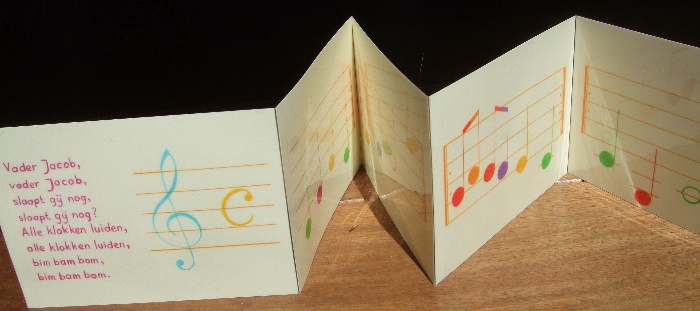
booklet Vader Jacob (Brother John)
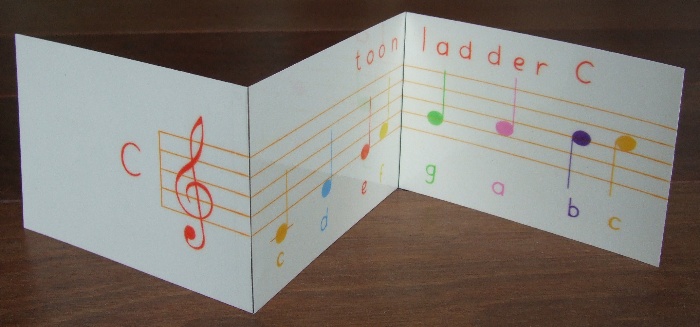
C major scale
| On this page I explain the music basics using teaching materials with coloured notes, apples and carrots. | photos music notes (drawn) and teaching materials |
|
songs When you click on one of the titles, you go to a page where I describe the songs. Vader Jacob, a 4/4 time Mieke hou je vast, a 2/4 time Een twee drie vier, hoedje van, a 4/4 time Oze wiezewoze, a 3/4 time Op de glijbaan, a 6/8 time Ik maak noten en muziek, a 2/2 time |
music theory intervallen (intervals) grote terts toonladders (major scales) kleine terts toonladders (minor scales) |
 booklet Vader Jacob (Brother John) |
 C major scale |
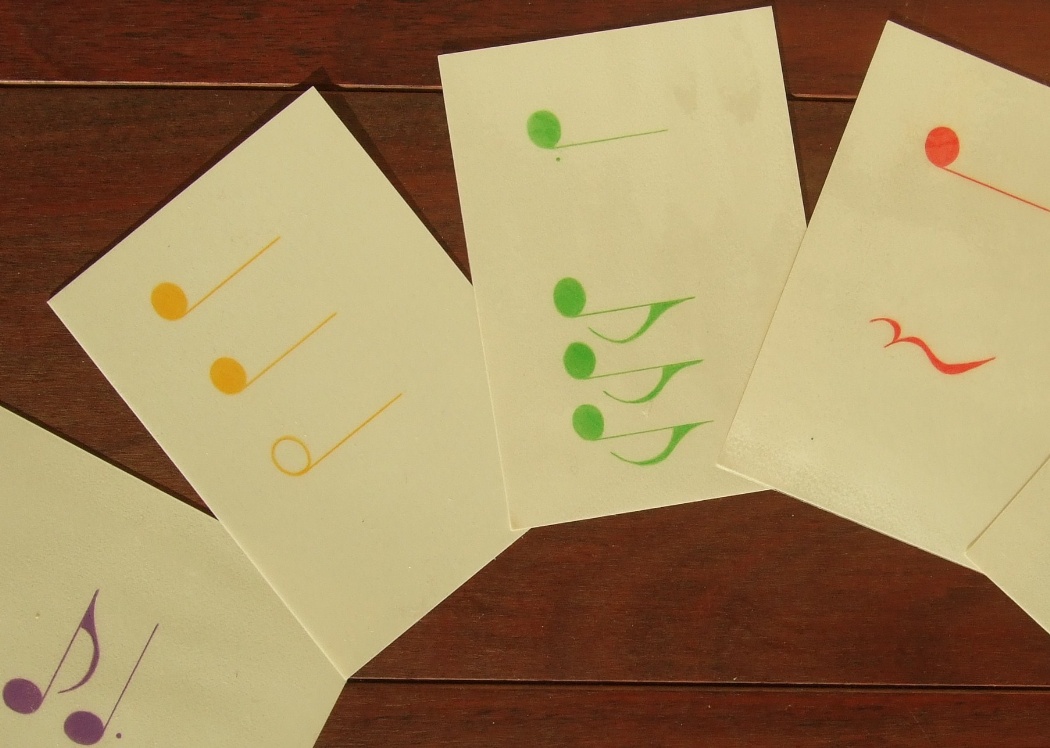 rhythm charts |
|
the booklets Jeannette draws the teaching materials with coloured pencils. There are known songs (size A6), songs written by Leonoor and songs made by children during the lessons. You can unfold the booklets, they are plasticized and have rhythm charts to match, which you can put under every bar of the song as a puzzle. There are charts (size A4) with 4, 5 and 6-part arrangements made by Leonoor. Children love to work with these colourful teaching materials. Also adults (until 100 years old!) appear to like to make the puzzles, indicate the notes while they sing or play the song. With these teaching materials children (from 3 years old) learn the music basics with understanding, see page children. |
|
what is needed to be able to make music Contact with each other, talking about how you build up confidence and how you work on a good atmosphere and how rest comes is essential. It's important that everyone can say what he or she likes and dislikes. When everybody feels heard, seen and understood there comes room to be open for each other, for what you feel and for new experiences. This seems to be easily said, but I know after 40 years of experience with music and much life experience that it takes a lot to get there. With children from 3 years old you can already talk about rest and they even understand the word concentration already. To work on rest and concentration is a condition to get round to creativity, feeling, playing and singing in tune. Good accompaniment and support is essential in this. --------------The more feeling you put in making music, the more beautiful it sounds. --------------------------And actually that goes for everything in your life. |
|
explanation of the booklets When you unfold a booklet you can indicate the notes of the song, while you sing the song. Like this you can see, hear and feel the music. The songs have coloured notes. Every tone has its own colour. The colours that are used, are different for every song. A c can be red in one song and green or blue in another song. Like that children don't learn to read colours, but notes. |
 C major scale |
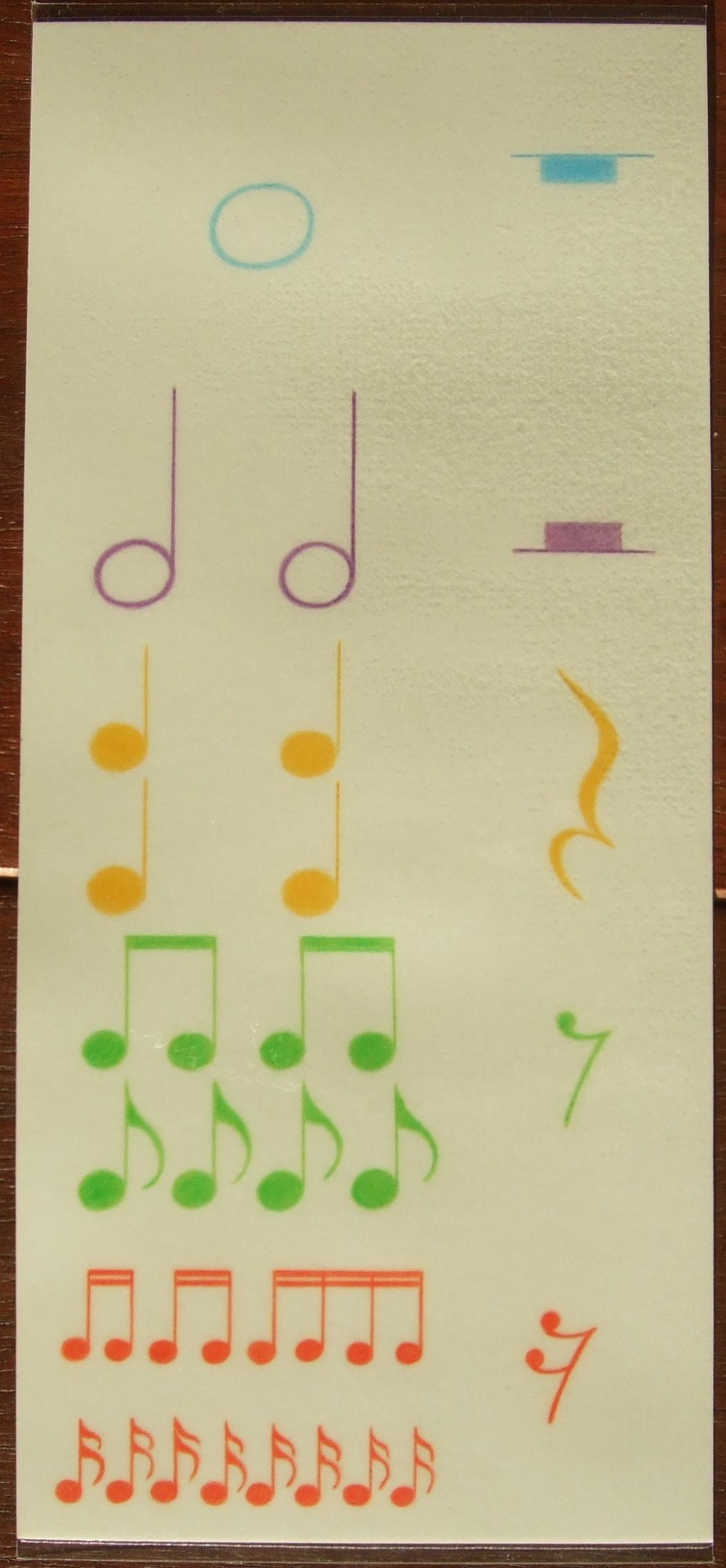 |
note values and rests |
 Vader Jacob (Brother John) with rhythm charts |
|
When you unfold Vader Jacob, children can put the 4 rhythm charts under the song as a puzzle. Like that you can see the melody , the high and low tones and the rhythm, long and short notes. You can sing Vader Jacob (Brother John), while you indicate the 16 notes. Everybody knows the song Vader Jacob (Brother John), you discover self that every time, every chart is being repeated. You can hear and see the high and low tones and when you listen well, you also hear which (4) tones are the shortest and which (2) tones are the longest. note names When you lay open a booklet and you put the C major scale above it, children can look for the note names in the scale themselves. De first note from Brother John (Vader Jacob) is green. When you ask which note it is on the scale, children often indicate the noteg on the scale, because that note is also green. Then, when you say no, that note is not the right one and you ask which note it could be, they mostly see that it is a c . You can also help by saying look at the line that goes through the note. When they discovered themselves that the first note is a c, you can still ask how many c's (5 or if you count the repeats 10) there are in Brother John and children can also name the other note names. The d under the first line, the e on through the first line, the f between the first and the second line etc. The naming of the lines helps to become aware of what you see. Now the notes are disconnected from the colours and so you can always make the connection with the existing sheet music. |
|
bamboo sticks and one tone bamboo flutes You can clap or tap the notes on the rhythm charts under the song with bamboo sticks. You can make bamboo sticks yourself, Ø 7 mm, length 20 cm. You can buy bamboo in a garden centre. We made bamboo flutes of one tone. With those flutes you can play songs together, everyone gets a flute. Brother John consists of seven different tones, so you need seven flutes to play the song with and you can play it with seven children (parents and other adults like to join in). You can see wich note you should play according to the pitch and the colour. Because everybody knows Brother John, you can see and hear when you play your tone. You can pass the flutes and like that always play another tone. You can also play with two or more flutes. Then you can play Brother John with three or four children. In order to play a melody fluently, you can divide the flutes in a way that one person never plays two different tones in succession. |
|
play your first song on an instrument Brother John has 7 tones and is very suitable for learning to play notes. But if you want to play your first song on an instrument you would better take the most simple songs Mieke hou je vast or Mary had a little lamb, these songs have 3 tones. Those can be the tones c d e, the songs then start on an e or the tones f g a, the songs then begin on an a or the tones g a b, the songs then begin on a b. Then you can look for the three tones on your instrument and start practising until the songs sound fluently. Well known songs have the advantage that you already know what it sounds like, that helps to find the tones and sounds on an instrument, for example Een twee drie vier, hoedje van has a range of 5 tones, c d e f g, or when you begin on the g it is g a b c d. |
|
staff, notes, clef, bars and times Every song is composed of four to six bars. One bar is always on one page or chart. A bar divides music in little pieces. Every bar ends with a bar line. There is always a double bar line (a thin and a thick line) at the end of a song. |
| In the booklets of the songs Vader Jacob and Oze wiezewoze there are two dots and a double double bar line at the beginning and at the end of a bar (in the first bar only at the end). It means you have to repeat that bar. |  1st and 2nd bar of Vader Jacob |
|
When you unfold a booklet, the first thing you see is the text of the song, after it you see the five lines of the staff. The lowest line is the first line. The notes of the song are on the staff. There are line notes and space notes. Line notes are through the lines, space notes are in between two lines. In front of the staff you see the clef, which is called G-clef, because the beginning of the clef indicates the note g. The g is the note which goes through the second line of the staff (seen from bottom to top). After it you see the time signature: |
|
2/4
two four time 3/4 three four time 4/4 four four time, also called common time 6/8 six eight time 2/2 two two time A big C is another way to mark the 4/4 time or common time. |
|
The first (or top) number (of the fraction) indicates how many beats or counts there are in a measure: Than two, three, four or six is the number of beats. The second (or bottom) number indicates which beats there are in a measure: half, quarter or eighth notes are the sort of beats. |
|
In a 2/4, 3/4 or 4/4 time the duration of the quarter note (note with a filled-in head and a stem) is one beat. Mieke hou je vast is a 2/4 time. There are two quarter notes (two beats) in every measure. Oze wiezewoze is a 3/4 time. There are three quarter notes (three beats) in every measure. Brother John, and Een twee drie vier, hoedje van have a 4/4 time. There are four quarter notes (four beats) in every measure. In a 6/8 time the duration of the eighth note (note with a filled-in head, a stem and a flag) is one beat. Op de glijbaan is a 6/8 time. There are six eighth notes (six beats) in every measure. In a 2/2 time the duration of the half note (open note with a stem) is one beat. Ik maak noten en muziek is a 2/2 time. There are two half notes (two beats) in every measure. |
| notes and rests |
 note values and rests
note values and rests |
A big size of the note values and rests is hanging on the door in our house, not too high, so that children can walk to it to indicate a note or a rest. | 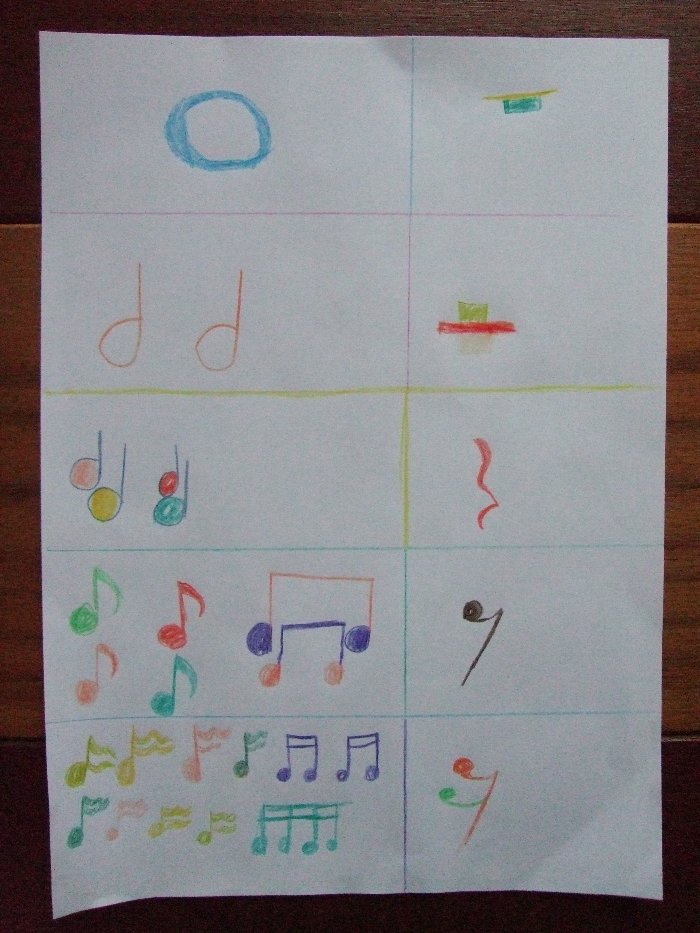 note values and rests drawn by Kiki
note values and rests drawn by Kiki |
|
From long to short you have whole, half, quarter, eighth, sixteenth and so on notes and rests: The whole note is an open note without a stem. The half note is an open note with a stem. The quarter note is a note with a filled-in head with a stem. The eighth note is a note with a filled-in head with a stem an a flag. The sixteenth note is a note with a filled-in head with a stem and two flags. Two, three, four or six eighth notes in succession are mostly connected with a beam. Rests are the silences in the music: The whole rest is a small beam hanging from the fourt line of the staff. The half rest is small beam resting on the third line of the staff. The quarter rest is a kind of twist. The eighth rest is a dot to which a kind of seven is attached. The sixteenth rest is a dot to which a kind of seven with an extra line is attached. The notes indicate the melody and the rhythm. You can sing the melody (a song) and it's indicated with the pitch, the note is higher or lower on the staff. You can clap or tap the rhythm (the rhythm charts) and it's indicated by the lenghth of the notes (whole, half, quarter, eighth, sixteenth notes and so on). The difference between notes and tones is nice and important to realize. Notes have names a b c d e f g, the first seven letters of the alphabet. You can read, write, indicate, name, clap or tap notes. Notes become tones when you start singing or playing. The more you sing or play tones with feeling, the more it becomes music. Names of notes can be absolute: --c --d --e --f --g --a --b --c or relative: --do --re --mi --fa --sol --la --ti --do. The do is the tonic of a song or piece of music. The tonic is the lowest tone of a song. When a song or piece of music is polyphonic the lowest last tone is the tonic. When the tonic is a c, the c is the do. When the tonic is a g, the g is the do. |
|
the biological apple We learn fractions with a pie, but because it's not so healthy, I got the idea to use an apple. It happens to be a big success. Children keep on asking for it. To be able to understand the note values whole, half, quarter, eighth, and so on, you can take a biological apple. |
|
The whole apple is a whole note. Two half apples are two half notes then. To make the four quarter notes you divide the apple in quarters. For the eighth notes you divide the apple in eight pieces. |
|
After it you can put matching pieces of apple under every rhythm chart of a song. When you ask a child how to eat an apple together or with four or eight children, also young children understand that you have to divide the apple in pieces. Children like it very much to cut the apple themselves. By making it visual children from seven years old really can understand it. You can make each measure of the song with an apple or count how many apples you need to make a whole song. When it went good children like to eat the apple(s). |
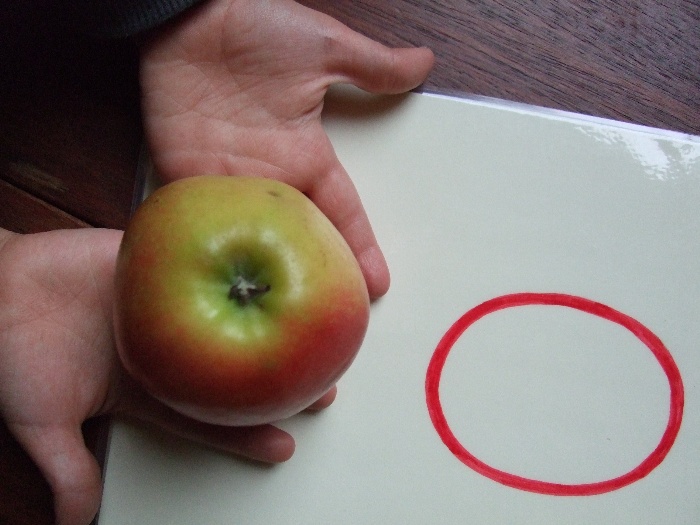 whole apple with whole note |
 half apples and half notes |
 four quarter apples next to four quarter notes |
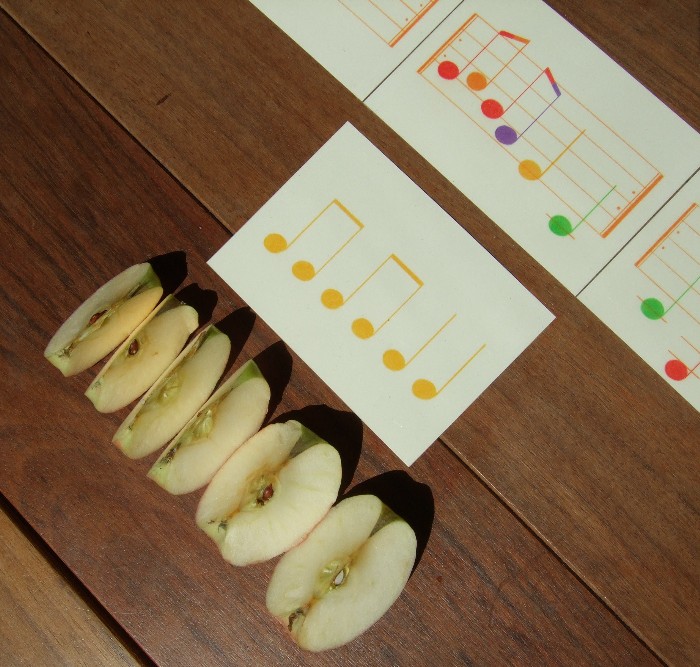 four eighth notes and two quarter notes |
|
the biological (large) carrot To explain the difference between note values and counting , is not so easy. Note values is about dividing, the fractions: whole note (1/1), half note (1/2), quarter note (1/4), eighth note (1/8) et cetera. The values and the duration of the notes becomes smaller, while the lowest number (the denominator) of the fraction 1/2, 1/4, 1/8, 1/16 and so on becomes bigger and bigger. It's quite difficult to understand that a whole note lasts four beats, a half note two beats, a quarter note one beat et cetera. Then I got the idea of a (large) carrot. I use the biological carrot, because it really tastes good. You can cut the carrot into slices. Every slice is one beat. |
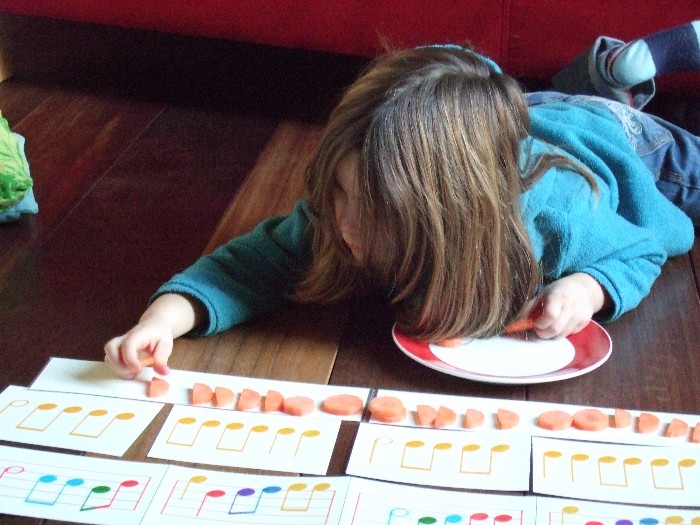 Melianna puts slices of carrot under a song |
|
In a 2/4, 3/4 or 4/4 measure the quarter note lasts one beat, you put one slice down, the half note two beats, you put two slices together, one on top of the other, the whole note four beats, you put four slices together, one on top of the other, the eighth note a half beat, you put a half slice down, the half note with a dot written after it (the dot increases the duration of the basic note by half of its original value) (two plus one) three beats, you put together three slices, one on top of the other, the quarter note with a dot (one plus a half) one and a half beat, you put down one slice with a half slice on it. Like apples children like to eat the carrots as well. |
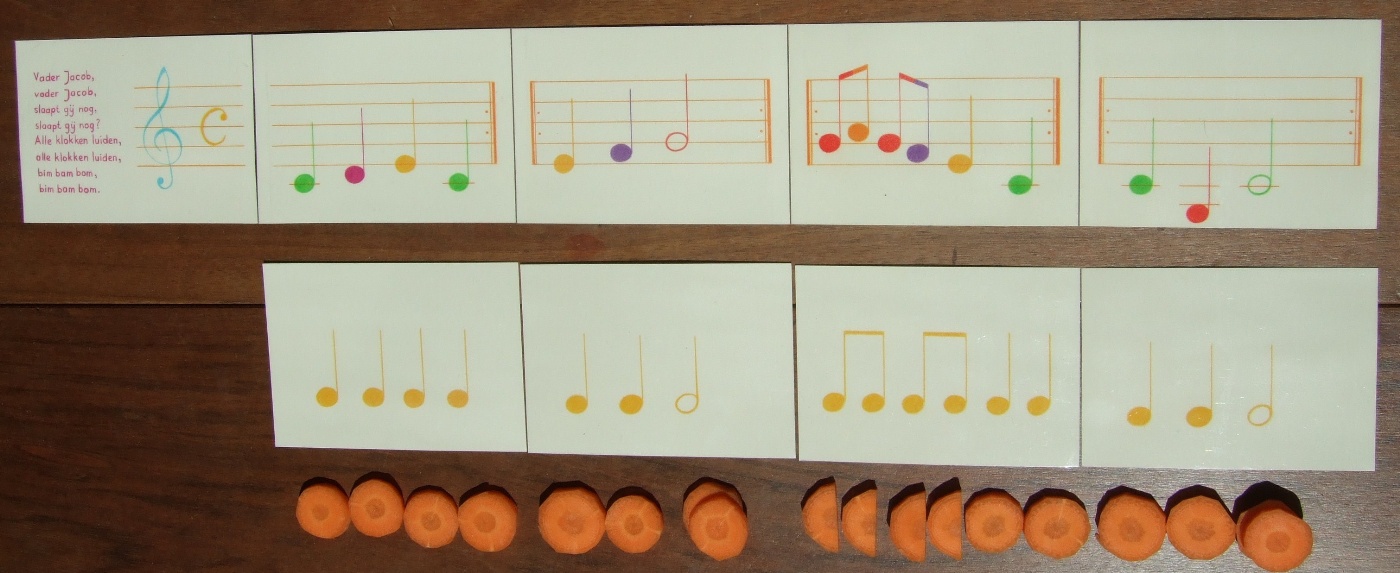 Brother John with rhythm charts and carrots |
| Finally you can combine both systems and put apples and carrots under the rhythm charts. To do this many times helps children to really understand note values and counting. |
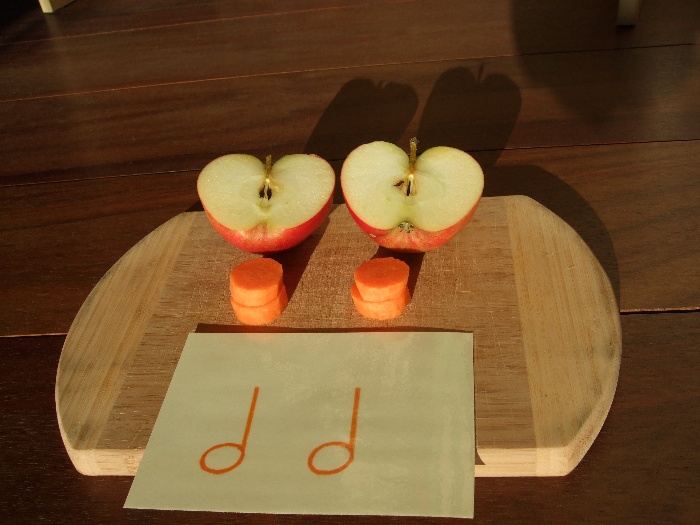 two half notes with apples and carrots |
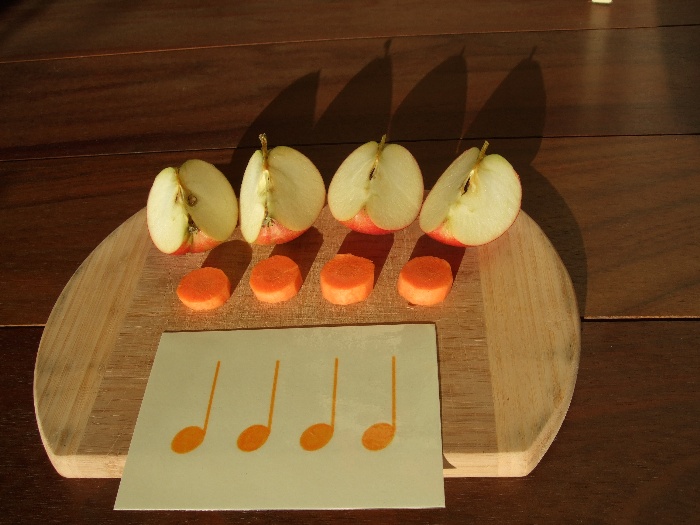 four quarter notes with apples and carrots |
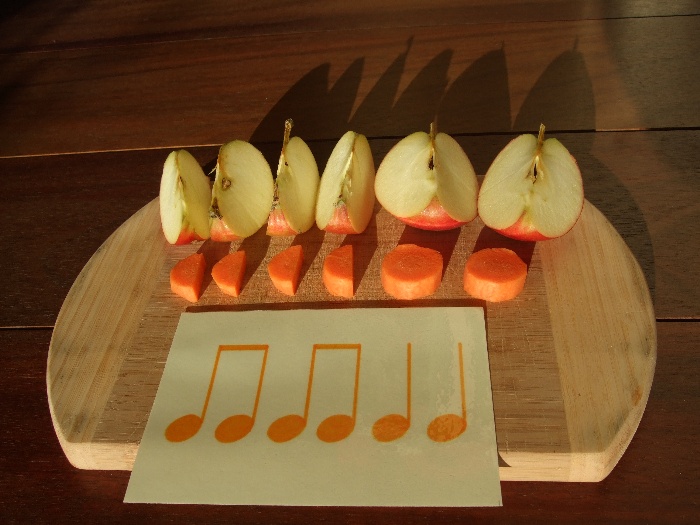 four eighth notes and two quarter notes with apples and carrots |
|
Instead of the words of a song, you can also sing the beats of a song. In the song Brother John 'Morning bells are ringing' becomes: one and two and three four. The whole song Brother John then goes like this: one two three four, one two three four, one two three-four, one two three-four, one and two and three four, one and two and three four, one two three-four, one two three-four. |
 'Au clair de la lune' with an own text drawn by Fenna |
To experience what notes are, drawing notes themselves is something very nice to do for children. You can draw the 5 lines of the staff with a ruler and
draw the G-clef on it. If it does not go yet, you can hold the colour pencil together and draw the clef or draw the clef very thin at first and let the child trace that clef. Then you can draw a song or the eight coloured notes of the
C major scale, with note names:
c
--d
--e
--f
--g
--a
--b
--c |
|
Children can also write down rhythms. If you understand that in a 2/4,
3/4, 4/4 measure all the time respectively two,
three, four quarter notes in one beat, you can
think of
2/4, 3/4, 4/4 measures yourself with different note
values and write down, which you can clap or tap with the bamboo sticks. And when they understand that in a 6/8 measure are six eighth notes in a bar and the bar is divided in two times three eighth notes, you can think of, write down and tap 6/8
measures. To make his/her own song together with a child is very nice. Children can think of words themselves and after that speak out the rhythm which matches with those words and write down that rhythm. After that you can sing the words and write down the notes. It is important to keep it simple, so that what comes out stays close to yourself, that asks for rest, patience and a quiet atmosphere. Leonoor |